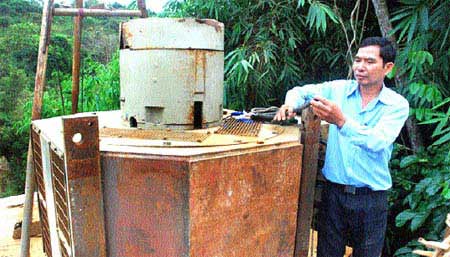
Ngo Van Quynh has spent 21 years creating green hydroelectric power plants. The three plants he built have a small capacity, but they save water, protect the environment and are quite economical.
Mr Fix It: Mechanic Ngo Van Quynh has a reputation as a man of action.
It's been a long road to get here. After the reunification of the country, Quynh returned home to Vinh Cuu District of Dong Nai Province to work on his farm.
"In the first days after liberation, electricity was not available across the whole country. Therefore, we badly needed power. As a mechanic, I nurtured the dream of making a hydroelectric plant. Putting a backpack on my shoulders, I went forth to various hydroelectric plants to ask people about their experiences," Quynh says.
Those trips helped him understand how the different parts of hydroelectric plants worked, especially the turbine system.
Today, the mechanic impresses visitors as a man of action, confident in every gesture.
When Quynh guides us to Hamlet 14 in Dak R'lap District in the southern part of the Central Highland, we're quite surprised by the extent of his work. After the remaining 20 percent is assembled, the project will have the capacity to generate 1.5MW of power.
A total of VND35 billion ($1,67 million) is usually required to complete a hydroelectricity plant of this kind [each MW costs VND25 billion ($1.19 million)].
Yet Quynh insists he only needs VND2 billion ($95,600) to generate the electricity and VND3 billion ($143,000) (to complete the construction.
"In my design, the dam's body is only one metre long. After a small amount of water is led into the turbine, the rest will flow over the dam, turning into natural current," says Quynh, pointing at the dam, a 60cm high and 30m long concrete structure barricading the stream.
We observe that the major dam and the spinway look as he describes, but we wonder how a 1.5MW plant can generate power with such a tiny water flow.
"Certainly, this small current could barely move a normal turbine. Yet my turbine is extraordinary," says Quynh confidently.
His turbine is modelled after the screw propeller of a boat. It can reach a huge spinning velocity, helping to save water. Additionally, the propeller is designed to make back-up natural gas to produce electricity for the dry season, something other power plants can hardly afford. Finally, it receives water from above, so a water pipeline is not needed.
"That is why I call my invention a green power plant," says Quynh.
In 1995, Quynh surprised locals living in Ma Da Commune, Vinh Cuu District, by making a 20kW plant by hand and using it to make ice for his family. Yet after five years, his project was shut down to give way to a communal economic programme.
"Ten years of research were wasted. I realised I would have to go somewhere else to keep building plants," he says.
After coming to the Central Highlands to test the water and terrain, he decided to move his family to Dak R'Moan Commune in Dak Nong Province.
"Just as in the southern province of Dong Nai, he left all crops and livestock to me and our kids, while he stuck to those projects. Although he had worked on hydroelectricity for over a decade, we still did not have enough money for our daily livelihood, as he spent everything on buying material and machinery and doing science research," says his wife, Vu Thi Dau.
After five years of living on the new land, Quynh built his second hydroelectric power plant, run by what he terms "green water power". This 1MW plant supplied power to over 150 local households in Tan Hoa and Tan Phong villages as well as the People's Committee of Dak R'Moan.
However, Quynh has still not seen a complete return on his investment. In 2010, his plant was ruined by the construction of another one in the region, so he decided to rebuild it.
"This one has a capacity of only 1.5MW and is rather primitive, but I want to show people what I have done and how it's beneficial for the environment," Quynh says.
Along with building plants, Quynh brought his ‘green' turbine to many technique exhibitions in Ha Noi and Quang Nam and received several contracts.
"Installing the green turbine on small streams is a perfect idea, as it will take advantage of the water from other power plants. However, I have to finish this power plant to complete the structure of the green turbine. What I fear most is not having enough capital, since I only concentrate on research and inventions and neglect to think about profits," he says.
Tran Viet Hung, deputy director of Dak Nong's Department of Science and Technology, says he advocates the idea of establishing an enterprise to produce green turbines.
"At present, we are trying to support Quynh with all the financial resources he needs so that he can complete the turbine. The idea can potentially be very useful, since in a time of declining water resources and environmentally harmful power plants like today, this technique can help produce a lot of electricity while minimising the effect on the environment," he says.

 Previous page
Previous page Back to top
Back to top







